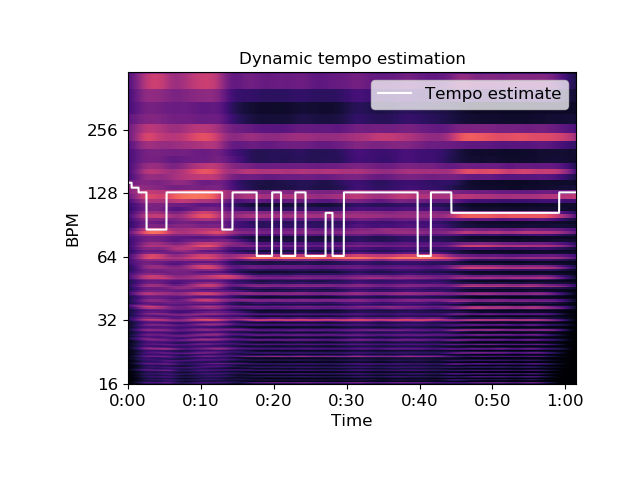librosa.beat.tempo¶
-
librosa.beat.tempo(y=None, sr=22050, onset_envelope=None, hop_length=512, start_bpm=120, std_bpm=1.0, ac_size=8.0, max_tempo=320.0, aggregate=<function mean>)[source]¶ Estimate the tempo (beats per minute)
Parameters: - y : np.ndarray [shape=(n,)] or None
audio time series
- sr : number > 0 [scalar]
sampling rate of the time series
- onset_envelope : np.ndarray [shape=(n,)]
pre-computed onset strength envelope
- hop_length : int > 0 [scalar]
hop length of the time series
- start_bpm : float [scalar]
initial guess of the BPM
- std_bpm : float > 0 [scalar]
standard deviation of tempo distribution
- ac_size : float > 0 [scalar]
length (in seconds) of the auto-correlation window
- max_tempo : float > 0 [scalar, optional]
If provided, only estimate tempo below this threshold
- aggregate : callable [optional]
Aggregation function for estimating global tempo. If None, then tempo is estimated independently for each frame.
Returns: - tempo : np.ndarray [scalar]
estimated tempo (beats per minute)
Notes
This function caches at level 30.
Examples
>>> # Estimate a static tempo >>> y, sr = librosa.load(librosa.util.example_audio_file()) >>> onset_env = librosa.onset.onset_strength(y, sr=sr) >>> tempo = librosa.beat.tempo(onset_envelope=onset_env, sr=sr) >>> tempo array([129.199])
>>> # Or a dynamic tempo >>> dtempo = librosa.beat.tempo(onset_envelope=onset_env, sr=sr, ... aggregate=None) >>> dtempo array([ 143.555, 143.555, 143.555, ..., 161.499, 161.499, 172.266])
Plot the estimated tempo against the onset autocorrelation
>>> import matplotlib.pyplot as plt >>> # Convert to scalar >>> tempo = np.asscalar(tempo) >>> # Compute 2-second windowed autocorrelation >>> hop_length = 512 >>> ac = librosa.autocorrelate(onset_env, 2 * sr // hop_length) >>> freqs = librosa.tempo_frequencies(len(ac), sr=sr, ... hop_length=hop_length) >>> # Plot on a BPM axis. We skip the first (0-lag) bin. >>> plt.figure(figsize=(8,4)) >>> plt.semilogx(freqs[1:], librosa.util.normalize(ac)[1:], ... label='Onset autocorrelation', basex=2) >>> plt.axvline(tempo, 0, 1, color='r', alpha=0.75, linestyle='--', ... label='Tempo: {:.2f} BPM'.format(tempo)) >>> plt.xlabel('Tempo (BPM)') >>> plt.grid() >>> plt.title('Static tempo estimation') >>> plt.legend(frameon=True) >>> plt.axis('tight')
Plot dynamic tempo estimates over a tempogram
>>> plt.figure() >>> tg = librosa.feature.tempogram(onset_envelope=onset_env, sr=sr, ... hop_length=hop_length) >>> librosa.display.specshow(tg, x_axis='time', y_axis='tempo') >>> plt.plot(librosa.frames_to_time(np.arange(len(dtempo))), dtempo, ... color='w', linewidth=1.5, label='Tempo estimate') >>> plt.title('Dynamic tempo estimation') >>> plt.legend(frameon=True, framealpha=0.75)

